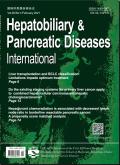急性胆管炎死亡率的早期预测:一种新的简单预后评分的阐述。
IF 4.4
3区 医学
Q2 GASTROENTEROLOGY & HEPATOLOGY
Hepatobiliary & Pancreatic Diseases International
Pub Date : 2025-06-23
DOI:10.1016/j.hbpd.2025.06.006
引用次数: 0
摘要
背景:急性胆管炎是由胆管梗阻引起的一种感染。尽管治疗取得了进展,急性胆管炎仍然具有潜在的致命性。早期诊断和治疗可改善患者的预后。本研究旨在确定入院时与急性胆管炎患者30天死亡率相关的临床和生物学因素,基于这些参数建立有效的预后评分,并研究这种新评分的性能。方法:纳入2017年1月至2021年12月期间因急性胆管炎连续住院的所有成年患者。我们开发了一个名为ProChol的评分系统,在多变量逻辑分析中使用与30天死亡率显著相关的变量,并基于简单的基于点的方法简化了该系统(名为sProChol)。结果:共纳入528例患者,平均年龄77±13岁,男性居多(54 %),主要病因为结石(69 %)。30 d死亡率为12 %。在多因素logistic分析中,肿瘤病因[调整优势比(aOR) = 15.43, 95 %可信区间(CI): 5.90-40.40],支架梗阻(aOR = 5.12, 95 %CI: 2.02-12.99),低白蛋白血症(aOR = 3.50, 95 %CI: 1.25-9.81),肾衰竭(aOR = 6.51, 95 %CI: 2.62-16.18),氧治疗(aOR = 4.63, 95 %CI: 1.02-20.92)和根治性抗凝(aOR = 2.60, 95 %CI:1.23-5.52)与30天死亡率独立相关,而发烧是一个保护因素(aOR = 0.37, 95 % CI: 0.16-0.84)。使用这7个参数的ProChol评分和使用3个稳健因素(病因、肾功能衰竭和抗凝)的sProChol评分分别显示受试者工作特征曲线下面积(AUC)为0.81和0.77,高于Tokyo评分(AUC = 0.72)和gravo - soares等评分(AUC = 0.71)。sProChol≥4的患者转入重症监护病房的风险明显更高(13.3 % vs. 5.1 %;P < 0.001)和更长的住院时间(P = 0.0006)。结论:根据入院时简单的临床生物学参数构建的ProChol和sProChol在预测急性胆管炎患者30天死亡率方面表现出有趣的性能。本文章由计算机程序翻译,如有差异,请以英文原文为准。
Early prediction of mortality in acute cholangitis: Elaboration of a new simple prognostic score
Background
Acute cholangitis is an infection due to the bile duct obstruction. Despite progress in treatment, acute cholangitis remains potentially fatal. Early diagnosis and treatment improve the patient outcomes. The present study aimed to identify clinical and biological factors at admission associated with 30-day mortality in acute cholangitis, to build an efficient prognostic score based on these parameters and to study the performances of this new score.
Methods
We enrolled all adult patients consecutively hospitalized for acute cholangitis between January 2017 and December 2021. We developed a score system named ProChol using variables significantly associated with 30-day mortality in multivariate logistic analysis and simplified this system (named sProChol) based on a simple points-based approach.
Results
In total, 528 patients were included, with an average age of 77 ± 13 years, a male predominance (54.2%) and a majority of lithiasis etiology (66.5%). Mortality in 30 days was 11.9%. In multivariate logistic analysis, tumor etiology [adjusted odds ratio (aOR) = 15.43, 95% confidence interval (CI): 5.90-40.40], stent obstruction (aOR = 5.12, 95% CI: 2.02-12.99), hypoalbuminemia (aOR = 3.50, 95% CI: 1.25-9.81), renal failure (aOR = 6.51, 95% CI: 2.62-16.18), oxygen therapy (aOR = 4.63, 95% CI: 1.02-20.92) and curative anticoagulation (aOR = 2.60, 95% CI: 1.23-5.52) were independently associated with the 30-day mortality while fever was a protective factor (aOR = 0.37, 95% CI: 0.16-0.84). ProChol score using these 7 parameters and sProChol using the 3 robust factors (etiology, renal failure and anticoagulation) presented respectively an area under receiver operating characteristic (ROC) curves (AUC) of 0.81 and 0.77, higher than Tokyo (AUC = 0.72) and Gravito-Soares et al. score (AUC = 0.71). Patients with sProChol ≥ 4 had a significantly higher risk of transfer to intensive care unit (13.3% vs. 5.1%; P < 0.001) and longer length of stay (P = 0.0006).
Conclusions
ProChol and sProChol constructed from simple clinico-biological parameters at admission, present interesting performances in predicting the 30-day mortality in acute cholangitis.
求助全文
通过发布文献求助,成功后即可免费获取论文全文。
去求助
来源期刊
CiteScore
5.40
自引率
6.10%
发文量
152
审稿时长
3.0 months
期刊介绍:
Hepatobiliary & Pancreatic Diseases International (HBPD INT) (ISSN 1499-3872 / CN 33-1391/R) a bimonthly journal published by First Affiliated Hospital, Zhejiang University School of Medicine, China. It publishes peer-reviewed original papers, reviews and editorials concerned with clinical practice and research in the fields of hepatobiliary and pancreatic diseases. Papers cover the medical, surgical, radiological, pathological, biochemical, physiological and historical aspects of the subject areas under the headings Liver, Biliary, Pancreas, Transplantation, Research, Special Reports, Editorials, Review Articles, Brief Communications, Clinical Summary, Clinical Images and Case Reports. It also deals with the basic sciences and experimental work. The journal is abstracted and indexed in SCI-E, IM/MEDLINE, EMBASE/EM, CA, Scopus, ScienceDirect, etc.

 求助内容:
求助内容: 应助结果提醒方式:
应助结果提醒方式:


